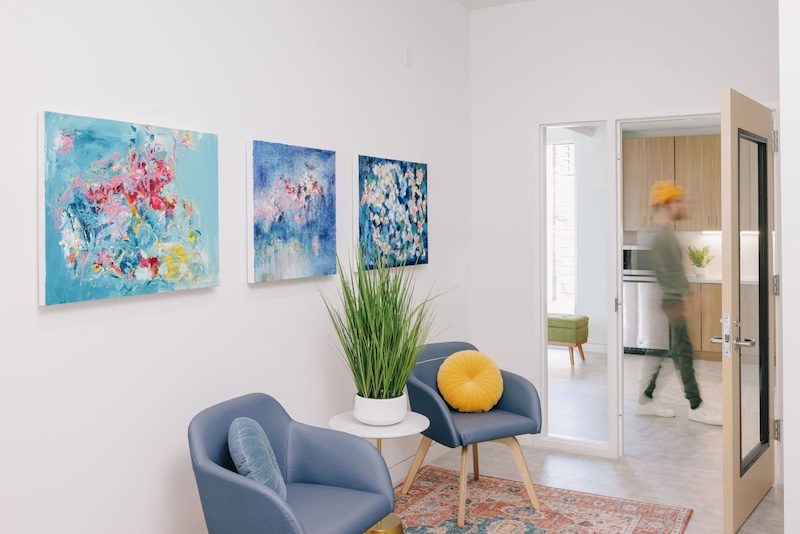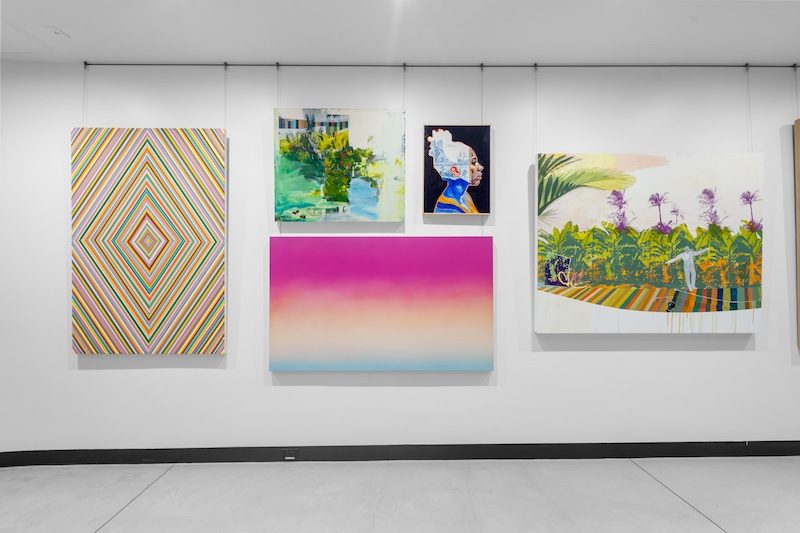As much as we all may love or admire art, there is one inescapable truth: after a while, it can get stale, especially in commercial spaces that have—or want—repeat visitors. Eventually, you don’t notice the art anymore, which can affect how guests, employees, and other visitors perceive the space and how much they think management cares. That’s where art rotations come in, keeping artwork and the space fresh.
Take this scenario: you’re the one in charge of design and art placement for a restaurant in a hotel, just off the lobby. Guests stream through every day—business travelers, vacationers, and regulars. When that big 8×8-foot piece in the entrance went up two years ago, people stopped. They talked about its colors, shapes, and what it made them think. Now? Few people glance at it. Most have seen it already. Given that the hotel has plenty of repeat business travelers and regulars, it’s not surprising. Ideally, changing the entire design would get people talking again, but the budget isn’t there.
Since the art made such an impression when it was first installed, maybe swapping it now could spark that interest again. Maybe changing it more often—on a schedule—could keep the space refreshed until a full redesign is possible.
This scenario, and others like it, are making designers and project managers rethink art placement as more than a one-time purchase. Rotating art periodically keeps a space engaging and can reinforce other themes, such as brand identity or local culture.
What is the best way to approach art rotations? Let’s take a look.
Why Rotations Work—By Space and Mind
Our brains are wired to look for change. It’s part of a survival mechanism that draws our attention to anything unusual, prompting us to investigate whether it’s a threat or an opportunity. When a new piece of art first appears, your mind goes into “orientation mode”: you notice the colors, shapes, or perhaps the artist’s style. But once that piece becomes familiar—an effect known as habituation—your brain tunes it out to conserve energy for other tasks. In a workspace, that means an impressive painting or photograph can fade into the backdrop, losing the impact it had when it was fresh and intriguing.
Reintroducing novelty pushes you out of that mental autopilot. Even if the swapped art isn’t radically different, it disrupts routine enough to catch the eye all over again. In some companies, those small changes prompt conversation—employees might ask each other if they noticed the new piece or share opinions about it. That bit of buzz can lead to a sense of dynamism: people feel like things are evolving, not stuck on repeat. It also creates an undercurrent of attentiveness; when the environment feels active, staff and visitors tend to stay more alert, which can help them tune in to other changes or opportunities around the workplace.
Where does this translate to real benefits? In a hotel lobby that sees repeat guests, for example, it can show attention to detail and give returning clients something new to notice, reinforcing the idea that management cares about the experience. In a retail setting, a refreshed display might encourage shoppers to slow down, browse longer, or ask about the updated décor. Meanwhile, a staff lounge that rotates art can keep morale a bit brighter—employees who pop in daily get a small mental reset when they see something different. On the flip side, spaces that rarely see the same faces (like hotel rooms with new guests every night) might not need frequent artwork changes, because each visitor still gets that “first-time” novelty.
At its core, rotating artwork leverages how our brains respond to fresh stimuli, using subtle visual shifts to keep people engaged. It prevents complacency from setting in and highlights that someone behind the scenes is paying attention to details. Whether it’s for employee satisfaction, customer retention, or plain visual interest, periodic updates can signal that your environment isn’t static or neglected—it’s lively, welcoming, and open to new possibilities.
How to Schedule Rotations for the Right Fit
Any plan for rotating artwork should start by examining each area of your space where you display art, identifying whether there’s a broader goal tied to that art, whether a rotation adds value for that goal, and whether the cost of rotating is justified by the potential benefits.
Begin by assessing each area of your commercial space that has art and consider if there was a purpose for its placement. Don’t worry if there wasn’t one—most art placements are primarily for aesthetics, but this evaluation gives you an opportunity to identify broader goals, which affects both the kind of art you choose and how often it might need to be refreshed.

Refreshing corporate break rooms with rotating blue-toned art fosters relaxation while keeping the space engaging and dynamic for employees. Artwork by Juliet Anne Fiss.
Let’s look at a break room as a common example in a corporate office environment. Staff go there every day to take a moment away from a hectic workload. The goal of encouraging relaxation and calm suggests placing mainly blue artworks as they are set that tone (for more see Unleashing the Inspiring Power of Corporate Art for Workplace Wellbeing,) However, since employees have repeated exposure to these pieces, they can lose their effect quickly, so updating more frequently makes sense. More frequent rotations also send a message to employees that management is paying attention to their experience.
However, since the employees have such a repeated exposure to the pieces, they can lose their effect quickly, so updating on a more frequent schedule than let’s say, the company lobby where the art is primarily there for visitors that come infrequently, makes sense. More frequent rotations also have the added benefit of communicating to the employees that management is paying attention to their well-being.
What should the rotation schedule be? Well, that depends on how important the goal is to the company versus the cost of making those updates.It’s probably best to start with a budget for art across the entire space over the course of a year, then look at each area and its goal, allocating a portion of that budget accordingly.
There are a few things to consider: the size of the area, the pieces themselves (how big they are, how many are needed to fill the space, whether to include originals or prints, the cost of each piece, and whether they’re framed or on canvas), plus how much traffic the area sees. You don’t want expensive or delicate original pieces in areas where they can easily be damaged.
Installation costs and shipping also come into play, as well as deciding what to do with the pieces once you no longer need them. For instance, to minimize costs, you could rotate artwork to another location—like between several retail shops or corporate offices—before replacing the pieces altogether.
By factoring in these options under the budget you’ve assigned to each space, you can determine the types of art, the quality level, and the frequency of rotations that make the most sense.
Outsourcing Your Art Rotation Plan
Even if you’ve mapped out a rotation plan, carrying it out can require more time and attention than many organizations have available. Between sourcing the right pieces, coordinating schedules, and keeping to a set budget, a lot of moving parts demand a level of focus not every team can spare. This is where an art consultancy steps in as a practical alternative. While there’s a fee for their services, that expense is often offset by saving on your own staff’s hours, leveraging a broader network of artists and suppliers, and drawing on experience that helps avoid costly missteps.
A reliable consultancy already knows where to source different types of art, whether you need durable prints for high-traffic areas or specific styles that reflect your organization’s identity. They’re also used to negotiating with both established and emerging artists, so they can often secure better pricing or terms than you might achieve on your own. Their access to pre-drafted contracts and established processes keeps things moving smoothly, reducing time spent on legal or administrative details.
Additionally, many consultancies can arrange consignment deals, giving you access to original works without having to purchase them upfront. If a piece sells, you simply rotate in a new one—an approach that would be harder to manage alone but becomes practical with a consultancy’s artist relationships and contract expertise.
Apart from the basic logistics, consultancies can maintain a clear vision of how each rotation supports your larger goals—helping you avoid random changes that might clash with branding or operational needs. They’ll consider how each piece fits into the budget over time, how it holds up under the traffic in each area, and whether rotating a particular style too often could drive up costs with minimal return. By making these calculations on your behalf, they free you to focus on core business activities rather than juggling decisions about frames, shipping, or insurance.
The upshot is that a consultancy’s experience—combined with their ability to streamline planning, tap into industry connections, and negotiate pricing—can make a significant difference. Even with a service fee, you’ll likely save by avoiding hidden expenses and spreading your costs more effectively. In the end, you gain a more cohesive, purposeful rotation strategy that stays on track with your financial limits and the impression you want to create in each space.
Case Study: ATP.art’s Gallery 85

Gallery 85’s rotating exhibition keeps corporate spaces vibrant and engaging, showcasing a dynamic mix of emerging and established artists to create an ever-evolving visual experience. Artwork by Christopher Paul Dean, Nick Stull, Lindsy Halleckson, and Sheldon Greenberg.
ATP.art’s Gallery 85, in the lobby of 85 10th Ave in Manhattan’s Chelsea arts district, shows how a structured rotation strategy can meet corporate goals. Twice a year, the gallery refreshes its display with emerging and established talent, ensuring variety without burdening building management.
By using a consignment model, Gallery 85 spares the company from purchasing artworks outright. If a piece sells, ATP.art replaces it, keeping the collection fresh for employees and visitors. Meanwhile, the consultancy handles shipping, insurance, and other logistics, saving the building’s staff a great deal of time.
Feedback from both the company and frequent guests has been overwhelmingly positive. Many praise the changing visuals for enhancing the lobby’s ambiance and aligning with the company’s aim to present a culturally engaged image—all while staying on budget and minimizing day-to-day workloads.
Wrap-Up
If you’re thinking about implementing or refining a rotation plan, consider starting small. Focus on one area, measure the response, and then adjust. Over time, you’ll develop an approach that fits both your budget and the atmosphere you want to create. If you decide to go all-in right away, an art consultancy can guide you through larger-scale changes, helping you sidestep pitfalls and ensure your resources are used wisely.
What about your space? Have you tried rotating art, or are you considering it? Drop a note in the comments—what kind of rotation are you envisioning, and which hurdles do you see along the way?
